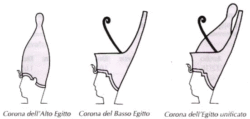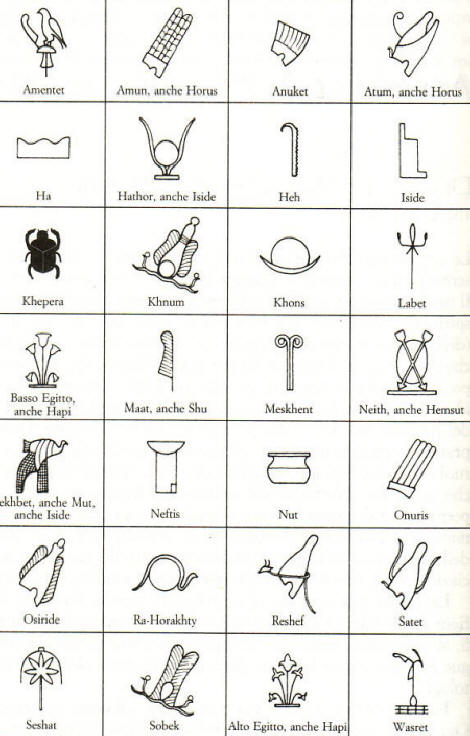ANCIENT EGYPT

The Egyptian crowns worn by the kings defined the pharaoh’s status in a certain moment of time.
The role could vary from the political one (head of the State), to the spiritual one (priest) to the moral one (teacher).
Even the Gods (divinities) wore headgears that were used to identify the roles they had in the world of the living and in the world of the dead and at the same time they were used to distinguish one from the other. These identifying headgears were sometimes exchanged moving the owner’s qualities to who was wearing it.

LEGEND
| Amentet | feather and bird on a support |
| Amun also Horus | two feather |
| Anuket | feather series |
| Aten | solar disk and sun rays (not illustrated) |
| Atum | double crown of Upper and Lower Egypt |
| Geb | ram feather and horn (not illustrated) |
| Ha | hieroglyphic for the desert and the hills |
| Hathor | ox horn and solar disk |
| Heh | notched palm leaf |
| Isis | hieroglyphic for the throne, sometimes with the shape of an ox horn and solar disk, others as a headgear shaped as a vulture |
| Khepera | beetle |
| Khnum | horns of ram and solar disk, Ba of Ra, Shu, Osiride and Geb |
| Khons | disk and scythe of moon |
| Labet (est) | normal lance |
| Lower Egypt and Hapi | normal lance |
| Maat | feather |
| Meskhent | uterus of cow |
| Nefer-Tum | flower of lotus (not illustrated here) |
| Neith | two cross arrows and shield with a red crown |
| Nekhbet | crown of Low Egypt or headgear to form of vulture |
| Neftis | “lady of the hieroglyph of the house”, basket on square |
| Nut | ceramics vase |
| Onuris | four feather |
| Osiris | Atef’s crown |
| Ra-Horakhty | solar disk or hawk, ram of the night |
| Reshef | horns of gazelle on the white crown of tall Egypt |
| Satet | it crowns white with horns of antelope |
| Serket | Scorpio (not illustrated) |
| Seshat | flower to five or you are stung, with horns |
| Shu | feather of ostrich (not illustrated) |
| Sobek | usually in partnership to two feathers, two snakes and a solar disk |
| Thot | ibis (not illustrated) |
| Upper Egypt | flower of lotus |
| Wasret | scepter was with ribbon |
THE SCEPTER
In the official representations, the pharaoh is often portrayed as he holds to his chest, his crook, the heka sceptre and the scourge ( nekhekh or nekhekhat) Osiris’s symbols.
The symbolism is evident: the pharaoh is the shepherd of his people, he protects them with the scourge and he guides them with the crook. Other symbols of the king’s power were the kherp sceptre, originally a cylindrical club which appeared as a battle weapon in the knife of Gebel al-Araq at the end of the pre-dynastic period and the khepesh which, in the New Reign was given by Amon to the sovereign as a reward for a victory.
The word sceptre defined many signs of the divine power and royalty.
Uas, the club which on top had a stylized head of a greyhound that evoked the animal sacred to Seth, and ended with a fork, was the scepter used by the gods.
Uadj, the stylized stalk of papyrus, similar to a papiriform column, was the goddesses’ magic scepter that symbolized the vigor and the eternal youth.
